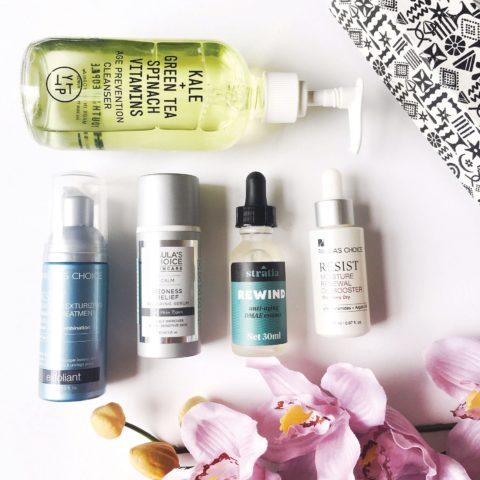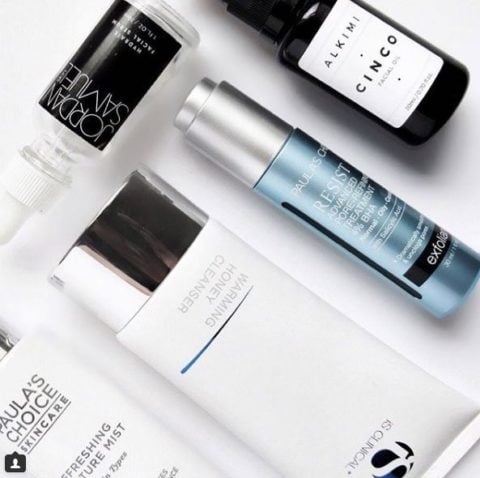Introducing Skinfluencers: The New Generation of Beauty Bloggers
Earlier this year, like a chill parent who suddenly takes on the role of bad cop, the U.S. Federal Trade Commission issued warnings about sponsored content on Instagram needing to be clearly labelled as an #ad or #spon. The concept is simple: Influencers, bloggers and celebrities who are paid to promote a product or service must be transparent about the fact that they’re making money off what they’re sharing with their followers.
The new rule hasn’t been without repercussions. Beauty bloggers, for one, have felt the backlash that comes with posting sponsored post after sponsored post to such a degree that it has led to the birth of a new subsection of beauty influencer: the skinfluencer. These new social media personalities are gaining followers by posting useful information about skincare routines and products instead of overstylized photos paired with brief captions that don’t say much at all. Their strategy is more along the lines of “research, research, research” than “snap, filter, post.”
Adri @sortofobsessed
“Once I get into something, I want to know everything about it,” says Southern California-based student Adri. “The name ‘@sortofobsessed’ fits into that.” With her beautifully lit photos shot on a millennial-pink backdrop, it’s safe to assume that her almost 32,000 Instagram followers come for the visuals but stay for the info. Each caption includes the name of every product, standout ingredients, likes and dislikes and whether or not she’d repurchase. “I Google ingredients in my downtime,” she says. “I want to know how things work.” Adri, whose Instagram bio includes her skin type (“Oily T-zone. Slightly dry elsewhere. Congested pores. Acne scars. Hormonal breakouts.”), cites Jordan Samuel Skin as one of her favourite brands: “Everyone needs to try them!” And while she only features products she actually uses (noting either her first impressions or even what she doesn’t like about a new product), she does admit to having done two paid posts in the past. “I don’t have anything against them,” she says. “I just want to do ones I truly like, and so far there have only been two.”
Sara Brooks @hydratedho
“I can’t remember the last time I bought a product without talking to someone who has used it before,” says Sarah Brooks (a.k.a. @hydratedho). “I’ll walk around Sephora and look up products on my phone. I’ve never purchased one without at least Googling it.” Only three months after starting her account, Brooks, a student in Boston, has amassed over 6,000 followers and an engaged comments section under her photos, where she always responds. She credits the conversation with the fact that consumers, like her, are becoming ingredient savvy. But understanding how to read the label on a product is more than an Instagram strategy. “Once I began reading about how certain ingredients can benefit skin, it made it easier to narrow down the products that would work for me,” she says. She hopes to pass on that info—but only if it’s honest. While Brooks accepts PR gifts occasionally, it’s on tight terms. “I will definitely turn down offers if they require a positive review or a certain amount of posts about the product,” she says. Needless to say, she’s quick to reject sponsored posts. “I have a lot of respect for bloggers who stay away from that kind of thing, so I’m holding myself to the same standard.”
Natalie Smyth @roadtoglow
“I do constant research,” says Natalie Smyth, the blogger behind @roadtoglow, of her pre-posting method. “[I read] books and scientific journals as well as articles on FutureDerm and Paula’s Choice.” It’s obvious that the skincare buff—whose daytime job is at an architectural firm—doesn’t skimp on details. “If I’m posting a somewhat lengthy and informative post, I spend days compiling research and then a couple of hours writing the post [to make it] as easily digestible as I can,” she says. While a couple of hours spent crafting an Instagram post might seem lengthy, one look at her captions, which can be paragraphs long, explains it. Smyth, who is based in Manchester, England, is the first to admit that @roadtoglow is more about facts than pretty photos (her #RTGIngredientSpotlight posts, in particular, include everything from history to scientific studies), and she’s totally fine with that. “I tend to focus more on the information provided than how it looks,” she says. “I still haven’t found my perfect aesthetic.” Her 10,900 followers don’t seem to mind, however, as every post garners hundreds of likes and dozens of questions and comments. “Most of the products I use are products I have bought myself,” she says. “I feel like it would be a disservice to my readers [otherwise].”
Tracy Robey @fanserviced
“I started out as a K-pop blog but eventually abandoned it,” says New York-based beauty and history journalist Tracy Robey. Robey was struggling with cystic acne, which forced her to rethink her skincare routine. “Acne is a painful and highly individualized problem,” she says. “I can help others with similar skin issues on an emotional and physical level.” These days her account, @fanserviced, has over 12,000 followers and comprises no-nonsense product photos paired with honest, funny reviews. (One memorable caption begins with “With this product, I feel like the last person in the friend group to have sex, the person who finally does what they’ve been hearing about all this time, and my response is…that’s it?”) That authentic tone is the cornerstone of @fanserviced. “I don’t accept money for posts,” she says. In fact, Robey declines almost all offered PR gifts. “I’d rather just buy stuff,” she says. “My account depends on readers trusting what I say, and people might feel betrayed by ad posts. I’m always curious about whether the amount of money someone receives for [an ad] is enough to offset the lost followers and the loss of [trust] from people who stick with them. I just don’t think it’s worth it for smaller accounts like mine.”
The post Introducing Skinfluencers: The New Generation of Beauty Bloggers appeared first on FASHION Magazine.











